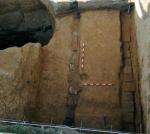Summary (English)
PLISKA (Stanislav Ivanov – stanislavivanovarh@gmail.com) The explorations in the northwestern part of the Palatial Square continued. Sunken-floored House No. 9 measured 3.30 m by 3m and had a stove built of stones and bricks and dug into the floor. Pit No. 12 was for storage. Pit No. 18 probably was a well and measured 2.70 m by 2.80 m, more than 10 m deep. Human skull and bones were discovered at 7.15 m depth. The pit was filled with burned debris, comprising three anonymous Byzantine folles of the Class B (AD 1030/1035 – 1042). Thus, the destruction could be related to the invasion of the Pechenegs in Pliska. House No. 9 and Pits Nos. 12 and 18 dated to AD 950 – 1050. The secret underground passages were thoroughly explored. The large secret passage was 3 – 3.30 m wide and was faced with timber planks. During the second period of its functioning, the passage was narrowed. The use of the passage preceded the construction of the stone fortification of the Inner Town and the brick fortification wall of the Citadel. The passage was constructed at the end of the 8th century AD and functioned during the first quarter of the 9th century AD. After it was abandoned, the small secret passage, 1.20 m wide, was constructed in its western part. The construction of the passage was coordinated with the building of the stone fortification of the Inner Town and the brick fortification wall of the Citadel. The passage was constructed during the 825 – 850s and it functioned until the 860s. It was subsequently filled with debris from monumental buildings, consisting of ashlars, fragmentary bricks, mortar, which contained sherds of the 9th century AD. Part of the southern trench of the timber fence that surrounded a yard was explored in Trench 105-O.
- Stanislav Ivanov - Shumen Branch of the Archaeological Institute and Museum
Director
Team
Research Body
- Shumen Branch of the Archaeological Institute and Museum






![Download [PDF]](/excavation/skins/fasti/images/results/download_sml.png)

